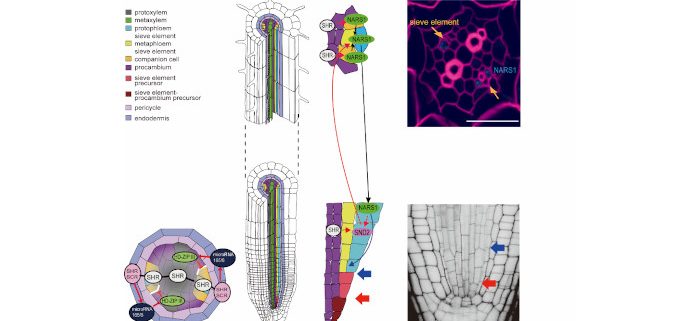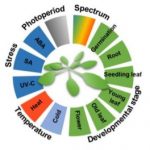SHORTROOT coordinates phloem development via two pathways
Kim et al. examine how plants coordinate sieve element and companion cell development.
Plant Cell https://doi.org/10.1105/tpc.19.00455
By Hyoujin Kim1 and Ji-Young Lee1,2, School of Biological Sciences, College of Natural Science, Seoul National University, 1 Gwanak-ro, Gwanak-gu, Seoul 08826, Korea1 Plant Genomics and Breeding Institute, Seoul National University, 1 Gwanak-ro, Gwanak-gu, Seoul 08826, Korea2
Background: Phloem is responsible for transporting photosynthetic products and other essential molecules from where they are produced (source) to where they are needed (sink). Phloem consists of sieve elements that act as conduits of molecules and companion cells that supply molecules to sieve elements. As a functional unit of phloem, sieve elements and companion cells should develop in a highly coordinated manner. However, underlying molecular processes have not been identified. The development of both sieve elements and companion cells is severely disrupted in the root meristem when a gene encoding SHORTROOT transcription factor is mutated in Arabidopsis thaliana. In the Arabidopsis root, SHORTROOT protein is produced in the xylem side of the stele and then moves to the phloem and the outer cell layer.
Question: We wanted to understand how the development of sieve elements and companion cells is coordinated. To this end, we dissected the phloem development and molecular pathways mediated by SHORTROOT in the root of Arabidopsis thaliana.
Findings: We found that SHORTROOT coordinates phloem development via two pathways. One is via the activation of microRNA 165/6 in the outer layer of the root stele. This is required for keeping the level of Homeodomain leucine zipper class III transcription factors under control, thereby maintaining companion cell development. The other involves the sequential activation of NAC-REGULATED SEED MORPHOLOGY 1 (NARS1) and SECONDARY WALL-ASSOCIATED NAC DOMAIN PROTEIN 2 (SND2), encoding NAC domain transcription factors, in the phloem. Under this regulatory scheme, NARS1 is generated in the companion cells of the root differentiation zone, and then establishes a top-down signal that drives the development of sieve elements in the meristem. SND2 appears to function downstream of NARS1 and amplify NARS1 expression via positive feedback regulation. This novel regulatory mechanism expands our understanding of the sophisticated tissue patterning processes during root growth and development.
Next steps: Phloem plays critical roles in allocating resources in plant bodies. Understanding the design principles of phloem development could facilitate engineering crops with better yields.
Hyoujin Kim, Jing Zhou, Deepak Kumar, Geupil Jang, Kook Hui Ryu, Jose Sebastian, Shunsuke Miyashima, Ykä Helariutta, Ji-Young Lee. (2019). SHORTROOT-Mediated Intercellular Signals Coordinate Phloem Development in Arabidopsis Roots. Plant Cell; DOI: https://doi.org/10.1105/tpc.19.00455




